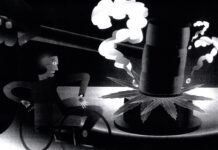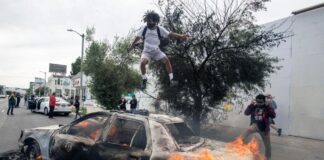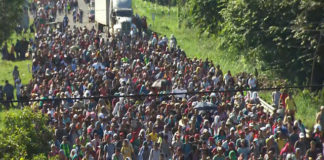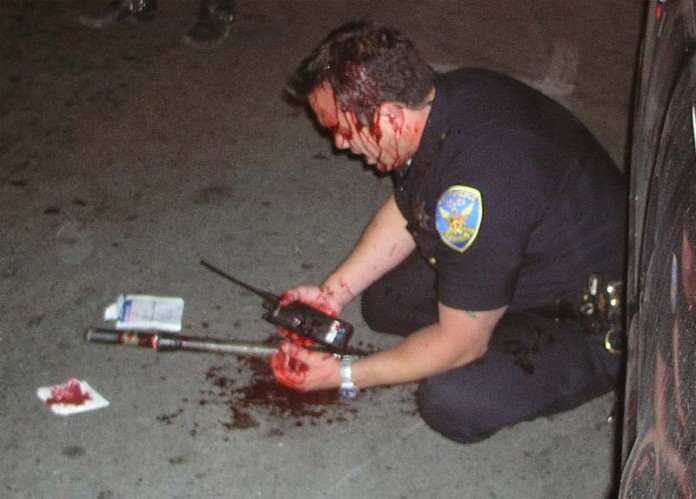
[With officers now down in Dallas tonight, and under siege in many other metropolitan areas across our nation, here’s a cover story I wrote for Los Angeles City beat almost eleven years ago about officer involved shootings, featuring something you don’t see much anymore these days in the establishment media: the perspective from the men wearing the badges and carrying the guns we gave them to protect our streets, our homes, our families. At the risk of losing theirs. More than a decade has gone by, yet not much has changed.]
It is by now a sadly familiar drill.
Police respond to a call, engage an angry man, confrontation escalates – sometimes within seconds – man produces gun, officers open fire, man dies, and the civic threads that bind us unravel a little more.
The smoke hadn’t even cleared from the used-car lot in Watts where Jose Raul Peña was shot dead by officers of the Los Angeles Police Department before the air began to thicken with accusations that SWAT team officers needlessly returned fire – killing Peña’s 19-month-old daughter Susie in the process.
Investigators were still collecting shell casings on the Avalon Boulevard lot when protestors and TV crews began to take their positions. Mayor Antonio Villaraigosa found himself in a role he’d better get used to: “calling for calm.”
The toddler’s mother, Lorena Lopez, waited little more than 24 hours before hiring a lawyer and blaming her daughter’s death squarely on the cops, even though Peña had been holding little Susie in one arm while blazing away at officers with his free hand. “I want justice,” Lopez declared, deferring comment on the 40 rounds her husband had fired at police, his teenage stepdaughter, and others during the nearly three-hour gun battle, which left one officer wounded.
And so the divide between the police and this particular community gaped open again, exposed and ugly. Just like it did during the shooting of Devin Brown. And again during the alleged beating of Nation of Islam leader Tony Muhammad last week. The police have better relations with other neighborhoods, but in Watts it is hardly a stretch for a man with a smoking gun to be transformed instantly by some into a guiltless victim after being downed by a cop. Decades of poverty and crime have left the community battling so many entrenched stereotypes – every young black or Latino man a gang-banger, every young woman a single, unemployed mother – that blaming “The Man” in the aftermath of a shooting is a defensive position for many, reinforced by years and years of loss. The truth of who was shot and why almost becomes an afterthought; it’s not as politically useful.
Already, three distinct views of the Peña shooting have emerged, with the street perspective steeped in the hyperbole necessary to convey fresh rage when rage is so common.
In the Socialist Worker Online, a report by Gillian Russom quotes numerous residents around the Watts neighborhood who maintain the police intentionally killed Peña’s infant daughter. The comments are strident and reflect a matter-of-fact view that killing infants is what the LAPD does.
According to Russom, who cites the Peña shootout as “the latest incident in a long pattern of racist violence by the LAPD,” the toddler was essentially executed by police following the police “murder” of 13-year-old Devin Brown earlier this year. “The way they shot up that place, there was no way they intended anybody to come out alive,” one activist told the Socialist Worker Online.
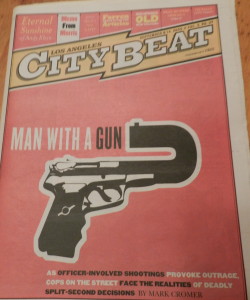
One woman addressing the Police Commission over the alleged beating of Tony Muhammad suggested that LAPD was putting mentally ill officers into the field.
Villaraigosa, while quick in his defense of LAPD officers who had to face down an enraged – and apparently coked-up – parent spraying gunfire at them while holding a baby girl, has seemed reluctant to aggressively challenge the activists’ basic assumption: that the LAPD is a terminally ill confederation of racist rogue cops.
Not surprisingly, the mayor is going to wait for the “transparent” investigation of the shooting to produce a report that he can read over his morning coffee before he steps up again.
Meanwhile, LAPD Chief William Bratton turned to the microphones and gave voice – however briefly – to the bitter frustration that his sworn officers have harbored as they are chronically second-guessed over their response to chaotic, fluid, and deadly confrontations. To say police across Southern California have a “siege mentality” is to completely misread what has happened. Cops on the beat today don’t look at it so much as “Us vs. Them” as much as they feel they are patrolling a twilight zone, an inverted reality where deadly force protocols are found under Section Catch-22.
The makeover of Peña into a dedicated father who “never would have done harm to his daughter” (according to one family member) was in full-swing when Bratton unloaded in front of the microphones, calling Peña as the cops saw it: a man with a gun trying to kill people.
Bratton’s comparatively fierce denunciation of Peña – which was still on the lighter side of what some cops were saying – was meant as much for his own men and women on the force as it was the public, a Post-It note to the ranks reading, “I know this guy was a shitheel who got his daughter killed. You did fine.”
Whether their tactics were flawless or not during any particular shooting, a fundamental consideration of these heated post-mortems has to be: What are the cops thinking? What are they confronted with night after night, shift after shift, in situations most people would run from?
A Pointed Gun
Police officer Mondo Lanier had to make that split-second decision on a January night in 1997. It had begun like any other night on the beat in Pomona: another eight-hour roll of the dice. Lanier knows the city and her streets well, having grown up in Pomona during the 1970s and early ’80s before joining the Army. By the 1990s, he was a cop in his hometown trying to “keep the old girl safe.”
Lanier and his partner were on patrol in the city’s south side, a perpetual hot-zone of gangs, dope, and guns. Sometimes the beat came up quiet, a rare calm punctuated more by barking dogs and sparring lovers than gunfire.
Yet, all too often, the beat turned bloody without warning, usually when the city’s venerable Latino street gangs, 12th Street and Cherryville, muscled each other and the smaller but equally violent black gangs like the South Side Village Crips, Angela Block Crips, Westside Mafia, .357 Crips, and Barjud Bloods.
On this night, it would turn deadly.
A “923” call crackled over the radio as dispatch relayed that a citizen was reporting gunfire – of the large caliber variety – in their beat. As Lanier pulled the radio car down a cul-de-sac close to where the shots had been fired, his partner tensed.
“He told me to stop the car,” Lanier recalls. “He had a gut feeling, a bad one. He said, ‘I think he can see us, but we can’t see him.’ Right then the hair went up on the back of my neck.” Fearing they might be driving into an ambush, Lanier quickly backed the cruiser out of the dead end and parked nearby.
“They call the inside of your unit a ‘kill zone,’” Lanier says. “If they open fire on you while you’re in the car, you don’t have a lot of options.”
Dispatch then radioed that a woman nearby was reporting someone was right outside her apartment door and that she could hear clicking sounds.
As they searched the area on foot, Lanier and his partner made their way down a long driveway toward a two-story apartment building. “We held our flashlights to the side of us, flashing them on and off, which can confuse a shooter in the dark,” Lanier says. “I had just started to check around the carports when I heard my partner shout ‘Pomona PD! Hands in the air!’”
At the top of the stairs leading up to the second floor of the building, Alfonso Coleman, 21, was crouched down. Instead of complying with the officer’s commands, in a split-second Coleman lifted a large handgun.
“I remember a volley of rounds being fired,” Lanier says. “It was almost as if everything happened in slow motion. Taking cover behind a VW bug was like trying to hide behind a beer can.”
Lanier and his partner fired 29 rounds in a matter of seconds. Lanier fired 15 times from his department-issued Colt .45 semiautomatic handgun – meaning he reloaded and fired again during the shooting. Coleman, a Pomona gang member, was hit a dozen times. He never got a shot off at the officers. The .357 Magnum he was holding was not loaded – but he was: on PCP. He died at Pomona Valley Hospital Medical Center shortly after the shooting.
“I felt I was being reactive to the guy with the gun,” Lanier says. “I don’t remember reloading. I know I felt very confidant in my partner. We did what we had to do, what we trained for.”
In the immediate aftermath of the shooting, the Los Angeles County Sheriff’s Department dispatched a “shoot team” to the scene to investigate the shooting, which is handled as a homicide investigation. Lanier and his partner were taken to the station and questioned separately.
“When I finally got home, I told my wife what had happened, then I went into my oldest daughter’s room. She was 10 years old at the time and she asked me what had happened,” Lanier says. “I told her that I had shot a man and she asked me why. I told her because he pointed a gun at me. She asked me if he was dead and I told her that he was. She said ‘good.’”
Lanier was back on patrol a few days later. The shooting was determined to be lawful and within policy. ´´
“Do I feel bad that I killed a man? No, I don’t,” Lanier says. “But I would have been pissed if I had been the one who ended up dead.”
‘Shoot Me’
Officer Glenn Stires is another local boy made good on the hard streets of Pomona, graduating alongside Lanier from Pomona High School in 1984 before joining the Air Force. He, too, returned from the service to become a cop in his hometown. A father of two, Stires has served on the department’s Major Crimes Task Force and its SWAT team.
In 16 years on the force, Stires has been in four shootings, one of them fatal. “That doesn’t count the couple of times that someone was shooting at me and I couldn’t return fire,” he says.
In every shooting Stires has been in, the suspect was armed with a gun. In every instance, the suspect refused to heed commands from either Stires or another officer.
On January 21, 2003, Stires responded to a call reporting that a man had just shot a child inside a Burger King on the west end of the city’s gritty Holt Boulevard. According to witnesses, Daniel Moreno, a 24-year-old Fontana gang member who had been sitting in the Burger King with friends, suddenly stood up and walked over to a mother and her children as they ate, pulled a gun from his pants and shot the woman’s two-year-old in the head – killing him instantly. Moreno then walked outside.
Stires and a Pomona Unified School District police officer who was also responding to the call were the first officers to arrive at the scene. Moreno was nearby standing next to a phone booth, talking to two people who quickly backed away as police approached.
“He was uncooperative. We were giving him commands to get his hands up and away from his waistband,” Stires says. “We told him to get his hands up, he said ‘Fuck you.’ We told him to get on the ground, he said ‘Fuck you, shoot me.’ We told him we didn’t want to do that, to just get down on the ground. He kept replying [with obscenities], so the school district officer pepper-sprayed him, got a good spray right in his face.”
But it wasn’t enough to subdue him.
As Moreno tried to wipe the burning spray from his eyes, the school district officer holstered his gun and stepped forward in an attempt to cuff him. As he did, the gang member stepped back and dropped a hand to his waistline.
“He reached into his pants pocket and pulled out a gun,” Stires says. “As he draws it out, I get two shots off. Just snap fire, two shots real quick, instinctive point shooting. Then I reset, got a good textbook shooting stance, and I fire three more rounds. He went down.”
As Stires was firing, the school district officer was shooting as well, emptying the 13-round clip from his .45 at the suspect. It was all over in a matter of seconds, with the two officers firing a total of 18 rounds, eight of which hit Moreno, including two through the heart. Moreno was declared dead at the scene.
The next day, as the toddler’s mother grieved for her murdered child, Moreno’s gang buddies erected a curbside memorial to him at the site of his death. Los Angeles County firefighters “accidentally” hosed it away later the same day.
As he looks back at the shootings he has experienced, Stires says he feels detached, but in an emotionally honest manner. He does not feel bad, he says, but he takes no joy in it either. He can ill-afford to allow emotion to cloud his reaction in the seconds he may have to respond to an armed suspect.
“For me, the way I have always mentally prepared myself, is there is no room for emotion,” he says. “There is fear for other people’s safety and fear for your own safety, but emotion clouds your ability to act or react and to make decisions. There’s no hate. There’s no animosity. It’s business. There is a given set of circumstances in front of you and you react to those circumstances, nothing personal against the person and there is nothing personal that they are doing to you.”
As far as an emotionally draining aftermath to a shooting, Stires says he doesn’t toss and turn at night. “I have never missed a day of work or a minute of sleep over a shooting,” Stires says. “That’s not bravado, that’s just a fact.”
Getting the Jump
Retired Sgt. Richard Madden is perhaps one of the closest approximations of a legend to walk out of the Los Angeles County Sheriff’s Department, known as much for his talents with the surfboard from Zuma to San Onofre as his ability to take down street predators from Lennox to Norwalk. Retired and living the good life on a golf course in wine country, Madden shook his head when he considered the continuing cycle of police shootings and the convulsions of community protests that inevitably follow.
Becoming a sheriff’s deputy in 1963, Madden said the department’s training tactics were just starting to expand. It was also a time when law enforcement could count on a baseline level of respect that has long since vanished today.
“Look, 30 and 40 years ago there was a whole different philosophy as to the way people looked at law enforcement. You were a father-figure,” he says. “If you told someone to stand there, they stood there.”
Well, at least for a few years. Madden was at the Firestone station when Watts erupted, a portent of things to come for the new deputy.
“A lot of my early background was riots. After Watts, I went into the Special Enforcement Bureau,” Madden says. “I went to the East L.A. riots, then more East L.A. riots, the Pomona riots, then up to Isla Vista [in Santa Barbara County, on a mutual aid call during Vietnam war protests].”
But one of Madden’s first encounters with the sudden-death stakes of a shooting occurred when California Highway Patrol officers Walt Frago and Roger Gore pulled over ex-cons Bobby Davis and Jack Twining on April 5, 1970, in Newhall, near Magic Mountain today.
The CHP officers had radioed for backup as they were pulling the pair over. They had tailed the car after matching it to the description of a vehicle in which a man had been seen brandishing a gun at other motorists. Both officers approached the car and ordered the driver, Davis, to get out and spread his hands on the hood. As Gore approached Davis at the hood of the car, patrolman Frago, armed with a shotgun, moved to the passenger side. At that moment, Twining sprang from the car and pumped two rounds into the chest of Frago, killing the patrolman instantly. Twining then spun and fired over the car at Gore, who apparently managed to get a panicked shot off before Davis, who had not yet been frisked, turned from the hood and shot Gore twice, killing him.
Just moments later, CHP officers George Alleyn and James Pence, responding to the call for backup, pulled up to the empty CHP cruiser, apparently unable to see either the slain officers or the suspects. Davis and Twining opened fire on them before they could fully get out of their patrol car.
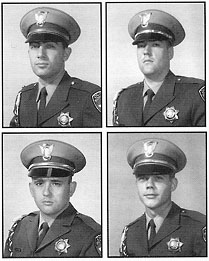
Both Alleyn and Pence were killed as they fired from the cover of their cruiser. One the most horrific details of the slaying came to light later, as investigators discovered that Twining was able to walk up and execute the wounded Pence at close range as he tried to reload his revolver. Before he shot Pence in the head, he reportedly shouted, “I’ve got you now, you son of a bitch.”
Immediately after the shooting, Madden was riding with two other deputies who fanned out with dozens of other officers, scouring the area in search of the killers. When a call came over the radio that a break-in had been reported at a nearby farmhouse, Madden and his partners were the first to arrive at the scene.
Jack Twining, who had broken into the home and taken hostages, made it clear he didn’t intend to be taken alive.
“We pulled in and get out of the car and I heard the screen door swing open and see this guy walking toward us and then ‘boom, boom, boom’ he’s shooting at us,” Madden says. The deputies returned fire and Madden took position in a garage next to the home.
As the night wore on and the home was surrounded by a small army of cops, a phone in the garage rang, apparently during an effort to contact Twining inside the house. Madden says he picked up the phone in the garage and found himself on the line with the killer.
“I talked to him for quite a bit,” he recalls. According to Madden, Twining described for him the moments leading up to the shooting of Gore and Frago. The two cons had briefly contemplated surrendering as they were pulled over.
“He told me that he was looking in the side-view mirror and they were debating whether they were going to give up. And he looks in the mirror and he could see [Frago] with the shotgun as he walked up to the car and there was still tape around the slide, which means there was nothing happening,” Madden says. The tape around the slide meant the patrolman had not cycled a round into the chamber – he wasn’t locked and loaded.
For a criminal like Twining, that was like the scent of blood in the air.
“He told me the patrolman actually looked embarrassed, like he didn’t want to be there. So [Twining] just said ‘Fuck it’ and bailed out and started shooting.”
Twining’s life came to an end shortly after he hung up the phone with Madden, as officers fired tear gas into the home and then stormed it. Twining killed himself with the shotgun he had taken from one of the patrolmen he murdered. Davis was arrested later and was last known to be serving a life sentence at Pelican Bay.
The Newhall shootings swept through law enforcement like a tidal wave, resulting in fundamental changes apparent even today in how police officers approach potential suspects, especially in what are now commonly known as “felony stops.” The underlying lesson of Newhall is simply: Never give a suspect the chance to get a jump on you.
Madden says that lesson is especially potent in officers’ minds now. “There are some officers who have been killed and there was nothing they could have done to prevent it because it was a straight-up ambush. But some of them get killed because they put themselves in a situation that they shouldn’t have,” he says. “They got lazy. And in this business there are people out there who are animals. There is no other word for them. If you give them the chance, they will take it. Period. In this day and age, do you think they are reluctant to shoot a cop? Not even.”
‘I Want To Go Home’
Sgt. Gary LeBeau knows that Madden is right, that police officers are dealing with an increasing number of thugs prowling the streets today who won’t hesitate to kill a cop any more than they would one of their civilian victims, providing they can get the draw on them. LeBeau has spent 15 years helping make sure cops are ready in the event they find themselves in a situation that – in the parlance of the beat – “goes to shit.”
An expert in the Los Angeles County Sheriff’s Tactics and Survival Training Unit, LeBeau is currently in charge of the department’s “laser village” course in Monterey Park. The five-acre village offers cadets the chance to prepare for the worst in a simulated urban environment, using real people (other officers) as a cast of suspects and civilians.
While the training unit is operated by the sheriff’s department, the 3,000 men and women who learn from their tactical experts each year come from a wide array of law enforcement agencies, including LAPD. It’s a long way from the days of shooting at stationary cardboard cutouts made to look like a mugger.
“The training has become much more realistic and much more challenging because of the role-playing scenarios that we put on now,” LeBeau says. “Years ago, the training was someone would come out with an obvious threat and [deputies] would respond. Now we get into more of a gray area. Is deadly force justified? Is it proper? It provokes a much more in-depth thought process because situations in the field always have some complicated factor in there.”
LeBeau says that officers today have more tools at their disposal than at any other time in law enforcement history, ranging from utility belts that are growing more crowded with various nonlethal gizmos, to professional communication skills that can diffuse a situation.
“Many things can be handled with that professional presence, that professional demeanor,” LeBeau says. “That presence is someone who carries themselves with confidence, is assertive yet polite. Respectful of the person they are contacting, yet very specific and direct as far as telling them what they are to do and what their expectations are.”
Ironically, as police departments employ more skilled officers with more technology at their disposal in an effort to avoid confrontations and make them less lethal, suspects are becoming increasingly belligerent to cops in an almost daring, taunting manner. It’s a game of chicken, with the suspects betting cops are more reluctant to shoot now – even justifiably.
Yet cops know if they hesitate in a clutch moment they could easily be killed. “We can’t wait until we see a gun, that’s been proven. Just due to reaction time,” he says. “The average gun battle in law enforcement lasts 2.5 seconds or less. It takes more than a second for a human to recognize a threat. You are dealing with millisecond time frames.”
Less than a year before Lanier and his partner shot and killed Coleman, Pomona Police Officer Daniel Fraembs stopped two Happy Town gang members and one of their girlfriends as they walked along a largely deserted industrial strip in the city’s south side. As Fraembs questioned one of the gang members, the other, 22-year-old Ronald Bruce Mendoza, approached him with the girl slightly in front of him. Mendoza then pushed her out of the way and shot Fraembs in the face, killing him instantly. Pomona’s first officer killed in the line of duty in the department’s 117-year history never got his gun out of its holster.
Captured, convicted, and sentenced to die, Mendoza declared killing Fraembs was “Just another day in the ’hood.”
Critics of the LAPD and of cops in general maintain just where the ’hood is makes all the difference in how police react. Russom’s report in the Socialist Worker Online quotes Watts resident Erika Kindell as saying Peña would never have been shot had he been a white man in Westwood. “They would have saved that baby’s life, even if it took a week,” the story quotes Kindell as saying.
The idea that a white guy can take hostages and shoot at people and that the cops are going to hold their fire because the street sign says Malibu or Bel Air is frustrating, to say the least, to cops.
As the debate rages about the necessity of the Peña shooting and whether the cops are trigger-prone in certain cases, it may help to keep in mind what Pomona’s officer Lanier says ultimately dictates his decisions in the field each night – no matter what neighborhood he is in.
“I want to go home,” he says. “I want to see my kids. And it’s a very fine line between rolling on a man with a gun call and ‘officer down.’”



